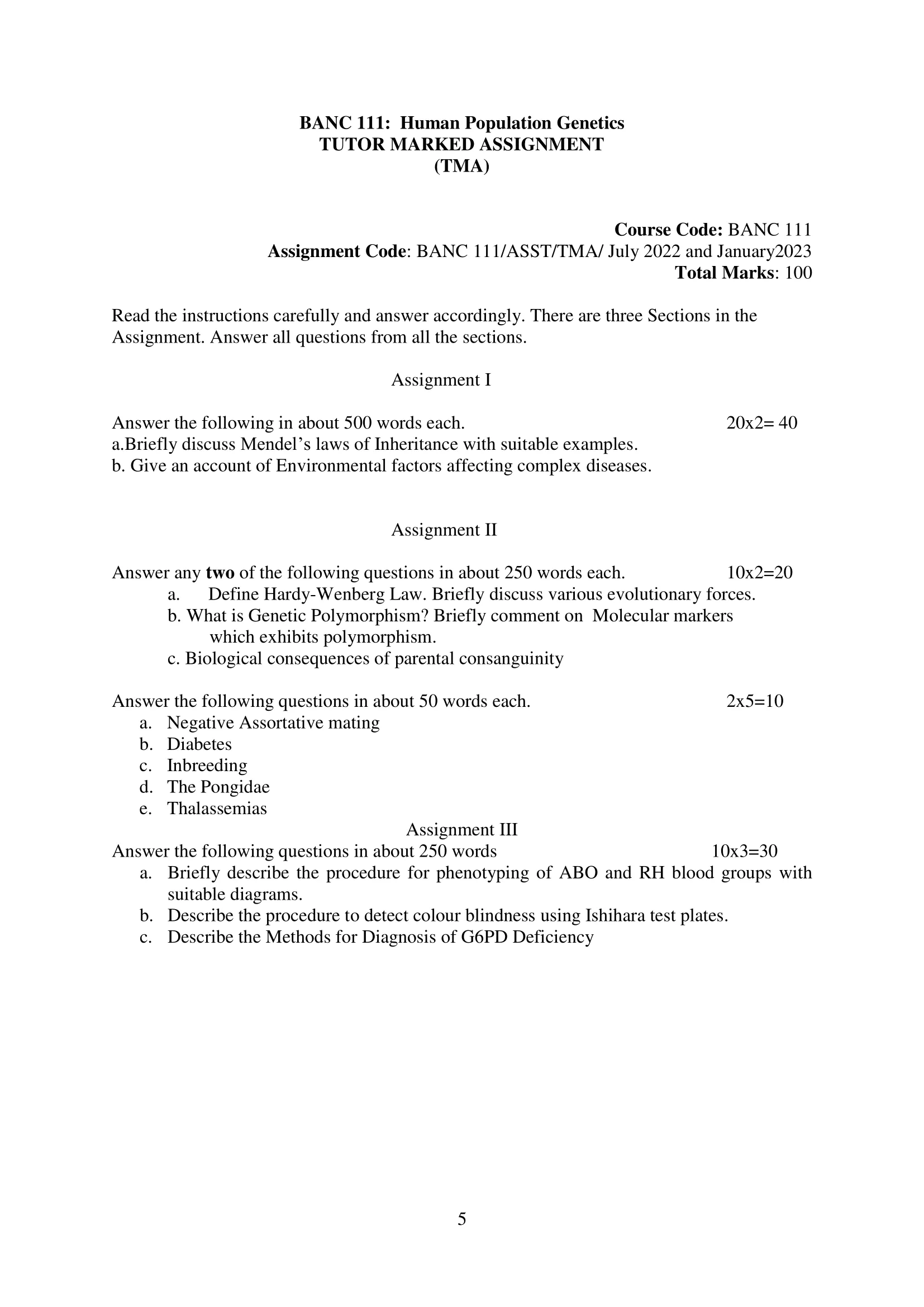Contents
- 1 Assignment I
- 2 Answer the following in about 500 words each. 20×2= 40
- 3 a. Briefly discuss Mendel’s laws of Inheritance with suitable examples.
- 4 b. Give an account of Environmental factors affecting complex diseases.
- 5 Assignment II
- 6 Answer any two of the following questions in about 250 words each. 10×2=20
- 7 a. Define Hardy-Wenberg Law. Briefly discuss various evolutionary forces.
- 8 b. What is Genetic Polymorphism? Briefly comment on Molecular markers which exhibits polymorphism.
- 9 c. Biological consequences of parental consanguinity
- 10 Answer the following questions in about 50 words each. 2×5=10
- 11 a. Negative Assortative mating
- 12 b. Diabetes
- 13 c. Inbreeding
- 14 d. The Pongidae
- 15 e. Thalassemias
- 16 Assignment III
- 17 Answer the following questions in about 250 words. 10×3=30
- 18 a. Briefly describe the procedure for phenotyping of ABO and RH blood groups with suitable diagrams.
- 19 b. Describe the procedure to detect colour blindness using Ishihara test plates.
- 20 c. Describe the Methods for Diagnosis of G6PD Deficiency.

| Title | BANC-111: IGNOU BAG Solved Assignment 2022-2023 |
| University | IGNOU |
| Degree | Bachelor Degree Programme |
| Course Code | BANC-111 |
| Course Name | Human Population Genetics |
| Programme Name | Bachelor of Arts (General) |
| Programme Code | BAG |
| Total Marks | 100 |
| Year | 2022-2023 |
| Language | English |
| Assignment Code | BANC 111/ASST/TMA/ July 2022 and January2023 |
| Last Date for Submission of Assignment: | For June Examination: 31st April For December Examination: 30th September |

Assignment I
Answer the following in about 500 words each. 20×2= 40
a. Briefly discuss Mendel’s laws of Inheritance with suitable examples.
Ans: Gregor Johann Mendel was an Austrian monk and botanist who is known as the “father of modern genetics”. He conducted experiments with pea plants and proposed three laws of inheritance that form the basis of classical genetics. These laws are:
- Law of segregation: This law states that during the formation of gametes (sex cells), the two copies of a gene (alleles) separate from each other so that each gamete only contains one allele. This law explains the 1:1 ratio of dominant to recessive traits observed in the offspring of a cross between heterozygous individuals (individuals with different alleles for a trait). For example, if a pea plant with round seeds (dominant trait) is crossed with a pea plant with wrinkled seeds (recessive trait), the offspring will have round seeds (dominant) because only one allele for seed shape is present in the gametes.
- Law of dominant and recessive traits: This law states that some alleles are dominant and others are recessive. A dominant allele will always express its phenotype (observable traits) in the presence of a recessive allele. A recessive allele will only express its phenotype when two copies are present (homozygous). For example, in pea plants, the allele for round seeds (R) is dominant over the allele for wrinkled seeds (r), so a heterozygous plant (Rr) will have round seeds.
- Law of independent assortment: This law states that the segregation of alleles for one trait is independent of the segregation of alleles for another trait. In other words, the inheritance of one trait does not affect the inheritance of another trait. For example, if a pea plant with round seeds and yellow seeds is crossed with a pea plant with wrinkled seeds and green seeds, the offspring will have a 1:1:1:1 ratio of round yellow, round green, wrinkled yellow, and wrinkled green seeds.
Mendel’s laws of inheritance provide a fundamental understanding of how traits are passed from generation to generation and form the foundation of modern genetics. They help explain how traits can be inherited in a predictable manner and how new combinations of traits can arise through sexual reproduction.
However, it should be noted that Mendel’s laws are a simplification of the complex process of inheritance and only apply to traits controlled by single genes with simple dominant-recessive relationships. In reality, most traits are controlled by multiple genes and can have more complex patterns of inheritance, such as incomplete dominance or codominance.
b. Give an account of Environmental factors affecting complex diseases.
Ans: Complex diseases, also known as multifactorial diseases, are illnesses caused by the interaction between genetic and environmental factors. Environmental factors play a critical role in the development and progression of complex diseases, including:
- Diet: The food we eat has a significant impact on our health, and certain dietary habits have been linked to an increased risk of complex diseases such as heart disease, diabetes, and certain types of cancer. For example, a diet high in saturated fats, refined sugars, and red meat has been associated with an increased risk of heart disease and certain types of cancer.
- Physical activity: Lack of physical activity is a significant risk factor for a variety of complex diseases, including heart disease, type 2 diabetes, and certain types of cancer. Regular physical activity has been shown to improve overall health and reduce the risk of complex diseases.
- Smoking: Smoking is a known cause of lung cancer and is also associated with an increased risk of heart disease, stroke, and several types of cancer. The harmful chemicals in tobacco smoke can cause damage to the body and contribute to the development of complex diseases.
- Exposure to toxins and pollutants: Exposure to toxins and pollutants, such as air pollution and chemicals, can increase the risk of complex diseases. For example, exposure to air pollution has been linked to an increased risk of heart disease, lung cancer, and respiratory problems.
- Stress: Chronic stress has been linked to a variety of complex diseases, including heart disease, type 2 diabetes, and mental health disorders. Stress can trigger the release of hormones that can harm the body over time and contribute to the development of complex diseases.
- Socioeconomic status: Socioeconomic status has been linked to the development of complex diseases, with individuals from lower socioeconomic backgrounds being at a higher risk for certain types of cancer, heart disease, and type 2 diabetes. This is due to a variety of factors, including limited access to healthy foods and safe environments, higher levels of stress, and reduced access to healthcare.
Assignment II
Answer any two of the following questions in about 250 words each. 10×2=20
a. Define Hardy-Wenberg Law. Briefly discuss various evolutionary forces.
Ans: Hardy-Weinberg Law: The Hardy-Weinberg law, also known as the Hardy-Weinberg equilibrium, is a basic principle of population genetics that describes how the frequency of genetic traits in a population remains constant from one generation to the next, in the absence of any external influences such as mutation, selection, migration, or genetic drift. It states that the frequency of alleles (versions of a gene) in a population will remain stable unless acted upon by evolutionary forces.
The Hardy-Weinberg equation can be used to calculate the expected frequency of different genotypes (combinations of alleles) in a population based on the frequency of their constituent alleles. This can help to detect deviations from the equilibrium that may result from natural or artificial selection or other evolutionary forces.
Various evolutionary forces:
- Mutation: Mutation is a permanent change in the DNA sequence that can result in the creation of new alleles or the alteration of existing ones. Mutations can lead to new traits in a population and thus influence evolution.
- Selection: Selection refers to the differential survival and reproduction of organisms with certain traits. Natural selection occurs when organisms with advantageous traits are more likely to survive and reproduce than those without those traits. Artificial selection occurs when humans select organisms with desired traits for breeding.
- Migration: Migration refers to the movement of individuals into or out of a population. Migration can introduce new genetic variation into a population, leading to evolutionary changes over time.
- Genetic drift: Genetic drift refers to random fluctuations in the frequency of alleles in a population. This can occur due to chance events such as the unequal distribution of alleles to offspring. In small populations, genetic drift can have a significant impact on the frequency of alleles and thus on the evolution of the population.
- Recombination: Recombination refers to the exchange of genetic material between homologous chromosomes during meiosis, which can result in the formation of new combinations of alleles. Recombination can increase genetic diversity in a population, leading to evolutionary changes.
b. What is Genetic Polymorphism? Briefly comment on Molecular markers which exhibits polymorphism.
Ans: Genetic Polymorphism: Genetic polymorphism refers to the presence of multiple forms, or alleles, of a single gene in a population. Polymorphism can result from mutations in the DNA sequence of a gene, leading to the creation of new alleles with different functions or properties. For example, genetic polymorphism can result in variations in eye color, hair color, blood type, or other physical traits.
Polymorphism is an important aspect of population genetics and evolutionary biology because it provides the genetic variation upon which natural selection can act. Populations with high levels of polymorphism are more adaptable to changing environmental conditions, as they have a greater number of alleles to draw from in response to selective pressures.
b. Molecular markers: Molecular markers are genetic sequences or regions of DNA that vary between individuals in a population and can be used to study genetic variation and diversity. Molecular markers exhibit polymorphism, meaning that they have multiple forms or alleles that can be used to distinguish individuals or populations.
There are several types of molecular markers, including single nucleotide polymorphisms (SNPs), insertion/deletion polymorphisms (indels), and microsatellites. These markers can be used in a variety of applications, such as in the mapping of disease genes, the study of population genetics, and the identification of individuals for forensic purposes.
SNPs are single base pair changes in the DNA sequence that can result in changes in gene function or expression. Indels are differences in the number of repeated DNA sequences, while microsatellites are short, repeating sequences of DNA. These markers are useful for population genetics studies because they are abundant and exhibit high levels of genetic diversity.
c. Biological consequences of parental consanguinity
Ans: Parental consanguinity refers to mating between close biological relatives, such as siblings, cousins, or other close relatives. The biological consequences of consanguinity can have significant impacts on the health and well-being of offspring.
- Increased risk of genetic disorders: When close relatives mate, they are more likely to share common alleles and genetic mutations. This increases the risk of offspring inheriting harmful recessive alleles, which can result in genetic disorders such as cystic fibrosis, sickle cell anemia, or Tay-Sachs disease.
- Reduced genetic diversity: Consanguinity can also lead to a reduction in genetic diversity, as offspring are more likely to receive the same or similar alleles from their parents. This can reduce the adaptability and resilience of the population to changing environmental conditions.
- Increased risk of birth defects: Consanguineous mating can increase the risk of offspring having birth defects or other physical or developmental problems. This is because the risk of inheriting harmful alleles is higher when close relatives mate, and these alleles can result in abnormalities in development or functioning.
- Increased risk of inherited diseases: Consanguinity can also increase the risk of inherited diseases such as Huntington’s disease, which is caused by a dominant allele that is more likely to be passed on to offspring when close relatives mate.
It is important to note that not all consanguineous mating results in adverse outcomes, and many consanguineous families have healthy offspring. However, the risk of negative consequences is generally higher with increased levels of relatedness, and it is recommended that individuals seek genetic counseling before engaging in consanguineous mating.
Answer the following questions in about 50 words each. 2×5=10
a. Negative Assortative mating
Ans: Negative assortative mating refers to the phenomenon where individuals with different traits are more likely to mate and produce offspring. This is the opposite of positive assortative mating, where individuals with similar traits are more likely to mate. Negative assortative mating can result in offspring with a wider range of traits and can increase genetic diversity within a population.
b. Diabetes
Ans: Diabetes is a chronic disease characterized by high levels of glucose (sugar) in the blood. It occurs when the body is unable to produce enough insulin or is unable to effectively use the insulin it produces. This leads to elevated blood sugar levels, which can damage organs and lead to a range of complications, including heart disease, nerve damage, blindness, and kidney disease. There are two main types of diabetes: type 1 and type 2, with the latter being more common and often related to lifestyle factors such as poor diet and lack of physical activity.
c. Inbreeding
Ans: Inbreeding is the mating of closely related individuals, such as siblings, cousins, or offspring and their parents. This practice can result in an increased frequency of harmful recessive alleles, leading to decreased genetic diversity and increased expression of genetic disorders. Over time, inbreeding can lead to reduced fitness, reduced fertility, and decreased survival, potentially leading to the decline of populations. However, in some species, inbreeding can also lead to the expression of desirable traits. It is important to consider the potential consequences of inbreeding and to carefully manage breeding programs to maintain genetic diversity and avoid negative impacts.
d. The Pongidae
Ans: Pongidae is a family of primates that includes the great apes, including gorillas, chimpanzees, and orangutans. These primates are known for their intelligence and are considered to be among the most closely related species to humans. The Pongidae family is an important model for the study of human evolution, as well as for understanding the evolution of primate behavior, social structure, and communication. Great apes are also of significant conservation concern, as several species, including gorillas and orangutans, are endangered due to habitat loss, hunting, and disease. Efforts to conserve and protect these species are ongoing, and include habitat preservation, captive breeding programs, and anti-poaching efforts.
e. Thalassemias
Ans: Thalassemias are a group of inherited blood disorders characterized by reduced or absent production of hemoglobin, the protein in red blood cells that carries oxygen. This leads to a reduced number of functional red blood cells, resulting in anemia. Thalassemias are caused by mutations in the genes involved in hemoglobin production and can range from mild to severe. Symptoms can include fatigue, weakness, pale skin, and shortness of breath. Severe forms of thalassemia can lead to organ damage and premature death if left untreated. Treatment options for thalassemias can include blood transfusions, iron chelation therapy, and bone marrow transplantation. Effective management and early diagnosis of thalassemias can help to improve outcomes and reduce the risk of complications.
Assignment III
Answer the following questions in about 250 words. 10×3=30
a. Briefly describe the procedure for phenotyping of ABO and RH blood groups with suitable diagrams.
Ans: Phenotyping of ABO and RH blood groups:
Phenotyping is the process of determining an individual’s blood type based on their blood cells’ physical characteristics, such as the presence or absence of specific antigens on the surface of red blood cells. The two most important blood grouping systems for human blood transfusions are the ABO and the RH (Rhesus) systems.
- ABO Blood Grouping System: The ABO blood grouping system is based on the presence or absence of A and B antigens on the surface of red blood cells. There are four possible ABO blood types: A, B, AB, and O. The procedure for phenotyping the ABO blood group involves the following steps:
- Blood Sample Collection: A sample of the individual’s blood is collected and used to create a blood smear on a microscope slide.
- Antigen Detection: The blood smear is then incubated with anti-A and anti-B antibodies, which will react with the antigens on the surface of the red blood cells.
- Observation: The slide is then observed under a microscope to determine the blood type based on the presence or absence of clumping or agglutination of red blood cells. If the red blood cells clump or agglutinate, it means that the individual has the corresponding blood type. For example, if the red blood cells clump when incubated with anti-A antibodies, the individual is type A.
- RH Blood Grouping System: The RH blood grouping system is based on the presence or absence of the Rhesus (Rh) factor antigen on the surface of red blood cells. There are two possible RH blood types: Rh-positive and Rh-negative. The procedure for phenotyping the RH blood group involves the following steps:
- Blood Sample Collection: A sample of the individual’s blood is collected and used to create a blood smear on a microscope slide.
- Antigen Detection: The blood smear is then incubated with anti-Rh antibodies, which will react with the Rh antigen on the surface of the red blood cells.
- Observation: The slide is then observed under a microscope to determine the blood type based on the presence or absence of clumping or agglutination of red blood cells. If the red blood cells clump or agglutinate, it means that the individual is Rh-positive, and if they do not, the individual is Rh-negative.
b. Describe the procedure to detect colour blindness using Ishihara test plates.
Ans: The Ishihara test is a widely used diagnostic tool for detecting color blindness, which is the inability to distinguish between certain colors or shades of color. The test consists of a series of plates, each of which displays a number or symbol made up of dots in different colors. The individual being tested is asked to identify the number or symbol on each plate.
The procedure for the Ishihara test is as follows:
- Test Administration: The individual being tested is seated in a well-lit room and is presented with a series of Ishihara test plates, one at a time.
- Visual Acuity Assessment: Before starting the test, the individual’s visual acuity is assessed to ensure that they are able to see the plates clearly.
- Plate Interpretation: The individual is asked to identify the number or symbol on each plate. If the individual is color blind, they may be unable to see the number or symbol because the dots are in colors that are difficult or impossible for them to distinguish.
- Recording Results: The results are recorded for each plate, and the overall pattern of results is used to determine the individual’s color vision status.
- Interpretation of Results: The results of the Ishihara test are interpreted based on the number of plates that the individual is able to correctly identify. A normal color vision individual should be able to correctly identify all or nearly all of the plates, while someone with color blindness may be unable to see some or all of the numbers or symbols.
c. Describe the Methods for Diagnosis of G6PD Deficiency.
Ans: G6PD deficiency is a genetic disorder that affects the body’s ability to produce an enzyme called glucose-6-phosphate dehydrogenase (G6PD), which is important for the production of energy in red blood cells. The deficiency can lead to the destruction of red blood cells, resulting in a condition called hemolytic anemia.
The following methods are used for the diagnosis of G6PD deficiency:
- Enzyme Activity Test: This is the most commonly used method for diagnosing G6PD deficiency. A small sample of the individual’s blood is taken and tested in a laboratory to measure the level of G6PD activity. A low level of G6PD activity in the blood indicates a deficiency.
- Gene Testing: This test involves analyzing the individual’s DNA to identify mutations in the G6PD gene, which is responsible for producing the G6PD enzyme. Gene testing can confirm a diagnosis of G6PD deficiency and can also be used to identify carriers of the disorder.
- Hemolysis Test: This test involves exposing the individual’s blood to a substance that would cause hemolysis (destruction of red blood cells) in individuals with G6PD deficiency. If the individual has G6PD deficiency, their red blood cells will be more sensitive to hemolysis, and the hemolysis test will be positive.
- Hemoglobin Electrophoresis: This test involves separating the different types of hemoglobin in the individual’s blood using an electric current. In individuals with G6PD deficiency, the red blood cells may contain an abnormal form of hemoglobin called hemoglobin F, which can be identified using this test.
How to Download BANC-111 Solved Assignment?
You can download it from the www.edukar.in, they have a big database for all the IGNOU solved assignments.
Is the BANC-111 Solved Assignment Free?
Yes this is absolutely free to download the solved assignment from www.edukar.in
What is the last submission date for BANC-111 Solved Assignment?
For June Examination: 31st April, For December Examination: 30th October















